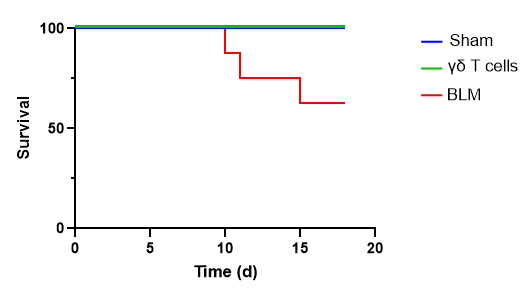Posted 13 May 2025 - 04:00 PM
Scientists from the Lifespan Research Institute have discovered that a subset of T cells effectively targets senescent cells and improves outcomes in a mouse model of idiopathic pulmonary fibrosis [1].
How do we harness the immune system against senescence?
Cellular senescence, which occurs when cells subjected to stress stop dividing and start emitting pro-inflammatory signals, is a double-edged sword. Senescence plays a beneficial role in various processes, such as embryonic development, wound healing, and early cancer surveillance. However, with age, the increasing burden of senescent cells starts contributing to various pathological phenotypes [2], which earned cellular senescence a place on the Hallmarks of Aging list.
Even in an aged organism, senescent cells are few and far between, and they are also highly heterogeneous, which is why going after them, as promising as it seems, is also not easy. Senescent cells are targeted by our immune system, but it suffers from its own age-related decline, becoming less efficient in dealing with threats [3]. On top of that, senescent cells can be good at evading immunosurveillance.
In a new preprint study, scientists from the Lifespan Research Institute, Cedars-Sinai Medical Center, University of Washington, and the Buck Institute for Research on Aging describe targeting senescent cells using a distinct gamma delta (γδ) subset of T cells.
The Swiss Army knife of T cells
In general, T cells are part of the adaptive immune system, but γδ T cells have certain innate-like properties. While conventional alpha-beta T cells respond to infected cells that display foreign peptides on major histocompatibility complex (MHC) molecules, γδ T cells recognize cells that are under various types of stress and respond quickly. The targets include senescent and cancer cells, which is why γδ T cells are also studied for potential anti-cancer applications.
“γδ T cells are widely recognized for their ability to interact and remove stressed cells,” said Gabriel Meca-Laguna from the Lifespan Research Institute, the study’s first author. “They have features from the adaptive and innate immune system and have received a lot of attention in the field of cancer because of their safety and efficacy.”
The researchers started by isolating peripheral blood mononuclear cells (PBMCs) from multiple human donors. They then selectively expanded a subtype of γδ T cells called Vγ9Vδ2 T cells, which are the most abundant in human blood.
The cells were then co-cultured with senescent and non-senescent cells. The scientists found that γδ T cells effectively kill senescent human fibroblasts and endothelial cells (senolysis) while mostly sparing non-senescent ones.
Comparing γδ T cell-enriched cultures with total PBMCs, the researchers found that the γδ T cells were the best at eliminating senescent cells. Cells from multiple donors were tested, and even with donor variability, most demonstrated consistent selectivity for senescent cells. Removing residual αβ T cells from the cultures further reduced off-target killing of non-senescent cells while preserving senolysis.
The killing was mediated via both γδ T cell receptors (TCR) and other receptors, NKG2D, which bind to stress-induced molecules on senescent cells. Blocking either receptor reduced cytotoxicity; blocking both nearly abolished it.
“Gamma delta cells are the Swiss Army knife of the immune system,” said Dr. Amit Sharma from the Lifespan Research Institute, the study’s corresponding author. “They appear to employ multiple redundant mechanisms in recognizing senescent cells, which may make them more resistant to the immune evasion mechanisms used by senescent cells.”
The researchers propose that metabolic rewiring in senescent cells, particularly changes in the mevalonate pathway, primes them for recognition by γδ T cells. In senescent cells, this pathway is disrupted in a way that leads to the accumulation of IPP, a small molecule that acts as a stress signal. This buildup appears to trigger the surface expression of BTN3A1, a key ligand that activates γδ T cells, making senescent cells visible targets for immune clearance.
Increased survival in an IPF model
Idiopathic pulmonary fibrosis (IPF) is a deadly and currently incurable disease, one of the few in which cellular senescence is known to play a key role. To test their γδ T cells “on the battlefield,” the researchers used a bleomycin-induced pulmonary fibrosis mouse model, a well-established model that mimics human IPF. There was a significant increase in γδ T cells in bronchoalveolar lavage (BAL) fluid, both in number and percentage. This confirmed that γδ T cells are recruited or expand in response to senescence-associated lung injury.
The researchers isolated and expanded mouse γδ T cells and transferred them into mice with bleomycin-induced fibrosis on days 8 and 11 post-injury. Compared to control mice, mice receiving γδ T cells showed less inflammation, lower fibrosis scores, and better survival.

“In this paper, we show that both human and mouse γδ T cells are very selective in killing senescent cells in cell culture assays,” said Sharma. “γδ T cells can be an essential therapeutic tool because they are considered allogeneically safe, so one can envision cord blood-derived γδ T cells or partially haplo-matched donor cells, similar to ongoing Phase 2 and 3 clinical trials where these cells are being used to target cancer.”
Sharma noted that it was somewhat surprising to see reversal of fibrosis, since not many treatments have been able to do that. “We plan to investigate the mechanisms more thoroughly, in addition to the cells’ senolytic functions,” he said.
“Ultimately, our hope is to help patients who suffer from age-related diseases driven by senescent cells, and this discovery is a big step forward,” Meca-Laguna added. “We are very excited to share these finding with the field and contribute to extending healthy aging.”
We would like to ask you a small favor. We are a non-profit foundation, and unlike some other organizations, we have no shareholders and no products to sell you. All our news and educational content is free for everyone to read, but it does mean that we rely on the help of people like you. Every contribution, no matter if it’s big or small, supports independent journalism and sustains our future.
Literature
[1] Meca-Laguna G, Admasu TD, Shankar A, et al. γδ T cells target and ablate senescent cells in aging and alleviate pulmonary fibrosis. bioRxiv. 2025 May 9.
[2] Childs, B. G., Durik, M., Baker, D. J., & Van Deursen, J. M. (2015). Cellular senescence in aging and age-related disease: from mechanisms to therapy. Nature medicine, 21(12), 1424-1435.
[3] Ventura, M. T., Casciaro, M., Gangemi, S., & Buquicchio, R. (2017). Immunosenescence in aging: between immune cells depletion and cytokines up-regulation. Clinical and Molecular Allergy, 15, 1-8.
View the article at lifespan.io











































